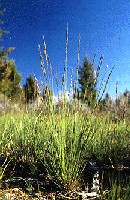| DESCRIPTION: It is a vigorous bunchgrass. Plants are strongly caespitose. Leaves are fine, dense, and mostly basal, with sheaths remaining firm and entire. Culms are densely tufted in large bunches, with tuft 15-25 cm high, usually more than 1/2 the length of culms. Culms are erect, from 0.3-1 m tall. Plants have a strong root system that can extend 40 cm deep in a 10 cm diameter plant. USE: It provides important forge for many types of domestic livestock and several wildlife species. It is slow to establish, but once established, has abundant growth of fine leaves that provide effective ground cover, and high yields of tough, fine, fibrous roots that control erosion and improve soil structure. GROWING PERIOD: Long-lived, cool-season perennial. COMMON NAMES Idaho fescue. FURTHER INF: Idaho fescue grows on many landforms, elevations, aspects, and soil types. It occurs at elevations from 300 m in Oregon to nearly 4000 m in Colorado. It occurs in a variety of ecosystems (grassland, sagebrush, forest, and alpine). In the grasslands of the intermountain region, it occurs in valleys, canyons, benches, slopes, and rolling hills bordering sagebrush/grasslands, juniper woodlands, or the lower treeline. It is most commonly found in mesic grasslands, but is also a component of the more xeric grasslands dominated by bluebunch wheatgrass, where it usually occupies the cooler, moister microsites on north and east aspects. |
